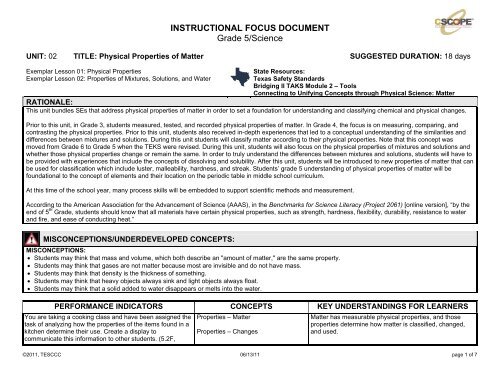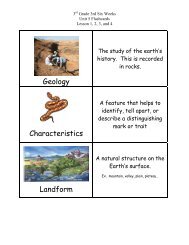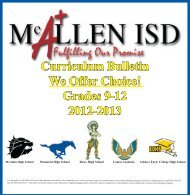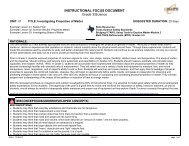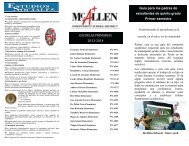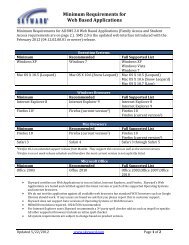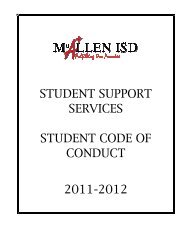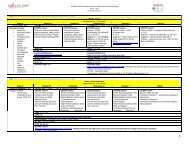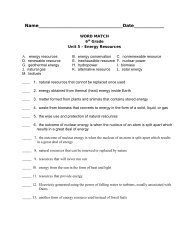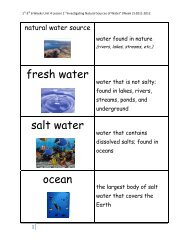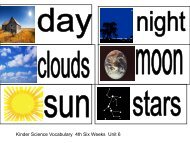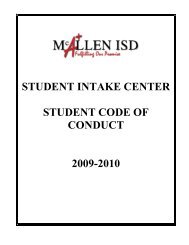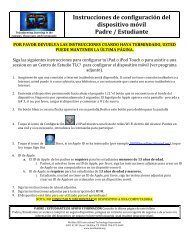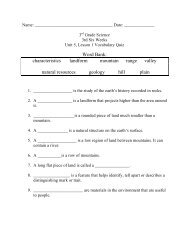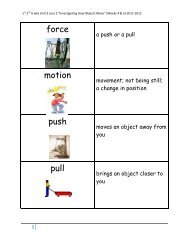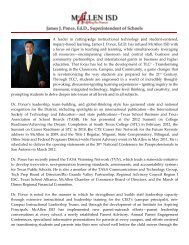INSTRUCTIONAL FOCUS DOCUMENT Grade 5 ... - McAllen ISD
INSTRUCTIONAL FOCUS DOCUMENT Grade 5 ... - McAllen ISD
INSTRUCTIONAL FOCUS DOCUMENT Grade 5 ... - McAllen ISD
You also want an ePaper? Increase the reach of your titles
YUMPU automatically turns print PDFs into web optimized ePapers that Google loves.
<strong>INSTRUCTIONAL</strong> <strong>FOCUS</strong> <strong>DOCUMENT</strong><br />
<strong>Grade</strong> 5/Science<br />
UNIT: 02 TITLE: Physical Properties of Matter SUGGESTED DURATION: 18 days<br />
Exemplar Lesson 01: Physical Properties<br />
Exemplar Lesson 02: Properties of Mixtures, Solutions, and Water<br />
State Resources:<br />
Texas Safety Standards<br />
Bridging II TAKS Module 2 – Tools<br />
Connecting to Unifying Concepts through Physical Science: Matter<br />
RATIONALE:<br />
This unit bundles SEs that address physical properties of matter in order to set a foundation for understanding and classifying chemical and physical changes.<br />
Prior to this unit, in <strong>Grade</strong> 3, students measured, tested, and recorded physical properties of matter. In <strong>Grade</strong> 4, the focus is on measuring, comparing, and<br />
contrasting the physical properties. Prior to this unit, students also received in-depth experiences that led to a conceptual understanding of the similarities and<br />
differences between mixtures and solutions. During this unit students will classify matter according to their physical properties. Note that this concept was<br />
moved from <strong>Grade</strong> 6 to <strong>Grade</strong> 5 when the TEKS were revised. During this unit, students will also focus on the physical properties of mixtures and solutions and<br />
whether those physical properties change or remain the same. In order to truly understand the differences between mixtures and solutions, students will have to<br />
be provided with experiences that include the concepts of dissolving and solubility. After this unit, students will be introduced to new properties of matter that can<br />
be used for classification which include luster, malleability, hardness, and streak. Students’ grade 5 understanding of physical properties of matter will be<br />
foundational to the concept of elements and their location on the periodic table in middle school curriculum.<br />
At this time of the school year, many process skills will be embedded to support scientific methods and measurement.<br />
According to the American Association for the Advancement of Science (AAAS), in the Benchmarks for Science Literacy (Project 2061) [online version], “by the<br />
end of 5 th <strong>Grade</strong>, students should know that all materials have certain physical properties, such as strength, hardness, flexibility, durability, resistance to water<br />
and fire, and ease of conducting heat.”<br />
MISCONCEPTIONS/UNDERDEVELOPED CONCEPTS:<br />
MISCONCEPTIONS:<br />
Students may think that mass and volume, which both describe an "amount of matter," are the same property.<br />
Students may think that gases are not matter because most are invisible and do not have mass.<br />
Students may think that density is the thickness of something.<br />
Students may think that heavy objects always sink and light objects always float.<br />
Students may think that a solid added to water disappears or melts into the water.<br />
PERFORMANCE INDICATORS CONCEPTS KEY UNDERSTANDINGS FOR LEARNERS<br />
You are taking a cooking class and have been assigned the<br />
task of analyzing how the properties of the items found in a<br />
kitchen determine their use. Create a display to<br />
communicate this information to other students. (5.2F,<br />
Properties – Matter<br />
Properties – Changes<br />
Matter has measurable physical properties, and those<br />
properties determine how matter is classified, changed,<br />
and used.<br />
©2011, TESCCC 06/13/11 page 1 of 7
<strong>INSTRUCTIONAL</strong> <strong>FOCUS</strong> <strong>DOCUMENT</strong><br />
<strong>Grade</strong> 5/Science<br />
UNIT: 02 TITLE: Physical Properties of Matter SUGGESTED DURATION: 18 days<br />
5.2G; 5.5A, 5.5B)<br />
1E; 5G<br />
PERFORMANCE INDICATORS CONCEPTS KEY UNDERSTANDINGS FOR LEARNERS<br />
Make two mixtures; one must be a solution. Identify<br />
whether or not the physical properties of the original<br />
substances in each change when the new mixtures are<br />
created. Produce a chart that documents changes, if any, in<br />
properties. (5.2D, 5.2F; 5.5C, 5.5D)<br />
1C; 5G<br />
Nature of Science<br />
Properties – Matter<br />
Properties – Changes<br />
Nature of Science<br />
Changes in water are caused by heating and cooling.<br />
Physical properties may remain the same in some<br />
mixtures, but may change in other mixtures.<br />
The physical properties of ingredients can change when<br />
they are combined into a solution.<br />
KEY ACADEMIC VOCABULARY SUPPORTING CONCEPTUAL DEVELOPMENT<br />
Matter – substance that has mass and takes up space<br />
Properties – characteristics used to identify matter<br />
Solution – a type of mixture in which the particles of one or more substances are uniformly dissolved throughout another substance<br />
Relative density – floating or sinking when compared to water<br />
TEKS#<br />
SE# TEKS<br />
5.1 Scientific investigation and reasoning. The student conducts classroom and outdoor<br />
investigations following home and school safety procedures and environmentally<br />
appropriate and ethical practices. The student is expected to:<br />
5.1A Demonstrate safe practices and the use of safety equipment as described in the<br />
Texas Safety Standards during classroom and outdoor investigations.<br />
SPECIFICITY<br />
Demonstrate<br />
SAFE PRACTICES<br />
Including, but not limited to:<br />
Washing hands<br />
STAAR Note:<br />
The process skills will be incorporated into at least 40% of the test questions and will<br />
be identified along with content standards.<br />
5.1B Make informed choices in the conservation, disposal, and recycling of materials. Make<br />
INFORMED CHOICES<br />
Including, but not limited to:<br />
In the conservation, disposal, and recycling of materials<br />
Laboratory materials<br />
©2011, TESCCC 06/13/11 page 2 of 7
<strong>INSTRUCTIONAL</strong> <strong>FOCUS</strong> <strong>DOCUMENT</strong><br />
<strong>Grade</strong> 5/Science<br />
UNIT: 02 TITLE: Physical Properties of Matter SUGGESTED DURATION: 18 days<br />
TEKS#<br />
SE# TEKS<br />
5.2 Scientific investigation and reasoning. The student uses scientific methods during<br />
laboratory and outdoor investigations. The student is expected to:<br />
5.2D Analyze and interpret information to construct reasonable explanations from direct<br />
(observable) and indirect (inferred) evidence.<br />
SPECIFICITY<br />
STAAR Note:<br />
The process skills will be incorporated into at least 40% of the test questions and will<br />
be identified along with content standards.<br />
Analyze, Interpret<br />
INFORMATION<br />
Including, but not limited to:<br />
Construct reasonable explanations<br />
Direct (observable) evidence<br />
Indirect (inferred) evidence<br />
STAAR Note:<br />
The process skills will be incorporated into at least 40% of the test questions and will<br />
be identified along with content standards.<br />
5.2F Communicate valid conclusions in both written and verbal forms. Communicate<br />
VALID CONCLUSIONS<br />
Including, but not limited to:<br />
Oral<br />
Written<br />
5.2G Construct appropriate simple graphs, tables, maps, and charts using technology,<br />
including computers, to organize, examine, and evaluate information.<br />
STAAR Note:<br />
The process skills will be incorporated into at least 40% of the test questions and will<br />
be identified along with content standards.<br />
Construct, Organize, Examine, Evaluate<br />
INFORMATION<br />
©2011, TESCCC 06/13/11 page 3 of 7<br />
Use<br />
TECHNOLOGY<br />
Including, but not limited to:<br />
Using technology<br />
Computers<br />
Graphs<br />
Tables<br />
Maps<br />
Charts
<strong>INSTRUCTIONAL</strong> <strong>FOCUS</strong> <strong>DOCUMENT</strong><br />
<strong>Grade</strong> 5/Science<br />
UNIT: 02 TITLE: Physical Properties of Matter SUGGESTED DURATION: 18 days<br />
TEKS#<br />
SE# TEKS<br />
5.4 Scientific investigation and reasoning. The student knows how to use a variety of<br />
tools and methods to conduct science inquiry. The student is expected to:<br />
5.4A Collect, record, and analyze information using tools, including calculators,<br />
microscopes, cameras, computers, hand lenses, metric rulers, Celsius<br />
thermometers, prisms, mirrors, pan balances, triple beam balances, spring scales,<br />
graduated cylinders, beakers, hot plates, meter sticks, magnets, collecting nets, and<br />
notebooks; timing devices, including clocks and stopwatches; and materials to<br />
support observations of habitats or organisms such as terrariums and aquariums.<br />
SPECIFICITY<br />
STAAR Note:<br />
The process skills will be incorporated into at least 40% of the test questions and will<br />
be identified along with content standards.<br />
Collect, Record, Analyze<br />
INFORMATION USING TOOLS<br />
Including, but not limited to:<br />
Notebooks<br />
Calculators<br />
Hand lens<br />
Metric Rulers<br />
Celsius Thermometers<br />
Triple Beam Balance<br />
Pan Balance<br />
Graduated Cylinder<br />
Beaker<br />
Hot Plate<br />
Magnets<br />
STAAR Note:<br />
The process skills will be incorporated into at least 40% of the test questions and will<br />
be identified along with content standards.<br />
5.4B Use safety equipment, including safety goggles and gloves. Use<br />
5.5 Matter and energy. The student knows that matter has measurable physical<br />
properties and those properties determine how matter is classified, changed, and<br />
used. The student is expected to:<br />
5.5A Classify matter based on physical properties, including mass, magnetism, physical<br />
state (solid, liquid, and gas), relative density (sinking and floating), solubility in water,<br />
and the ability to conduct or insulate thermal energy or electric energy.<br />
SAFETY EQUIPMENT<br />
Including, but not limited to:<br />
Safety goggles<br />
Gloves<br />
STAAR Note:<br />
The process skills will be incorporated into at least 40% of the test questions and will<br />
be identified along with content standards.<br />
©2011, TESCCC 06/13/11 page 4 of 7<br />
Classify<br />
MATTER BASED ON PHYSICAL PROPERTIES
<strong>INSTRUCTIONAL</strong> <strong>FOCUS</strong> <strong>DOCUMENT</strong><br />
<strong>Grade</strong> 5/Science<br />
UNIT: 02 TITLE: Physical Properties of Matter SUGGESTED DURATION: 18 days<br />
TEKS#<br />
SE# TEKS<br />
Readiness Standard<br />
5.5B Identify the boiling and freezing/melting points of water on the Celsius scale.<br />
Supporting Standard<br />
5.5C Demonstrate that some mixtures maintain physical properties of their ingredients<br />
such as iron filings and sand.<br />
Supporting Standard<br />
5.5D Identify changes that can occur in the physical properties of the ingredients of<br />
solutions such as dissolving salt in water or adding lemon juice to water.<br />
Supporting Standard<br />
SPECIFICITY<br />
Including, but not limited to:<br />
Mass<br />
Magnetism<br />
Physical state<br />
Solid<br />
Liquid<br />
Gas<br />
Relative density (sinking and floating)<br />
Solubility in water<br />
The ability to conduct or insulate thermal or electric energy<br />
Identify<br />
CHANGES IN WATER CAUSED BY HEATING AND COOLING<br />
Including, but not limited to:<br />
On the Celsius scale<br />
Boiling point of water<br />
Freezing point of water<br />
Melting point of water<br />
Density<br />
Demonstrate<br />
THAT SOME MIXTURES MAINTAIN PHYSICAL PROPERTIES OF THEIR INGREDIENTS<br />
Including, but not limited to:<br />
Iron filings and sand<br />
Sand, salt, and water<br />
Identify<br />
CHANGES THAT CAN OCCUR IN THE PHYSICAL PROPERTIES OF THE<br />
INGREDIENTS OF SOLUTIONS<br />
Including, but not limited to:<br />
Salt in water<br />
Lemon juice in water<br />
TEKS#<br />
SE# Scientific Process TEKS: Use appropriate Scientific processes to support instruction.<br />
5.1 Scientific investigation and reasoning. The student conducts classroom and outdoor investigations following home and school safety procedures and environmentally<br />
appropriate and ethical practices. The student is expected to:<br />
©2011, TESCCC 06/13/11 page 5 of 7
<strong>INSTRUCTIONAL</strong> <strong>FOCUS</strong> <strong>DOCUMENT</strong><br />
<strong>Grade</strong> 5/Science<br />
UNIT: 02 TITLE: Physical Properties of Matter SUGGESTED DURATION: 18 days<br />
5.1A Demonstrate safe practices and the use of safety equipment as described in the Texas Safety Standards during classroom and outdoor investigations.<br />
5.1B Make informed choices in the conservation, disposal, and recycling of materials.<br />
5.2 Scientific investigation and reasoning. The student uses scientific methods during laboratory and outdoor investigations. The student is expected to:<br />
5.2A Describe, plan, and implement simple experimental investigations testing one variable.<br />
5.2B Ask well-defined questions, formulate testable hypotheses, and select and use appropriate equipment and technology.<br />
5.2C Collect information by detailed observations and accurate measuring.<br />
5.2D Analyze and interpret information to construct reasonable explanations from direct (observable) and indirect (inferred) evidence.<br />
5.2E Demonstrate that repeated investigations may increase the reliability of results.<br />
5.2F Communicate valid conclusions in both written and verbal forms.<br />
5.2G Construct appropriate simple graphs, tables, maps, and charts using technology, including computers, to organize, examine, and evaluate information.<br />
5.3 Scientific investigation and reasoning. The student uses critical thinking and scientific problem solving to make informed decisions. The student is expected to:<br />
5.3A In all fields of science, analyze, evaluate, and critique scientific explanations by using empirical evidence, logical reasoning, and experimental and observational testing,<br />
including examining all sides of scientific evidence of those scientific explanations, so as to encourage critical thinking by the student.<br />
5.3B Evaluate the accuracy of the information related to promotional materials for products and services such as nutritional labels.<br />
5.3C Draw or develop a model that represents how something works or looks that cannot be seen such as how a soda dispensing machine works.<br />
5.3D Connect <strong>Grade</strong>-level appropriate science concepts with the history of science, science careers, and contributions of scientists.<br />
5.4 The student knows how to use a variety of tools and methods to conduct science inquiry. The student is expected to:<br />
5.4A Collect, record, and analyze information using tools, including calculators, microscopes, cameras, computers, hand lenses, metric rulers, Celsius thermometers, prisms,<br />
mirrors, pan balances, triple beam balances, spring scales, graduated cylinders, beakers, hot plates, meter sticks, magnets, collecting nets, and notebooks; timing devices,<br />
including clocks and stopwatches; and materials to support observations of habitats or organisms such as terrariums and aquariums.<br />
5.4B Use safety equipment, including safety goggles and gloves.<br />
The English Language Proficiency Standards (ELPS), as required by 19 Texas Administrative Code, Chapter 74, Subchapter A, §74.4, outline English language proficiency<br />
level descriptors and student expectations for English language learners (ELLs). School districts are required to implement ELPS as an integral part of each subject in the<br />
required curriculum.<br />
School districts shall provide instruction in the knowledge and skills of the foundation and enrichment curriculum in a manner that is linguistically accommodated commensurate with the student’s<br />
levels of English language proficiency to ensure that the student learns the knowledge and skills in the required curriculum.<br />
School districts shall provide content-based instruction including the cross-curricular second language acquisition essential knowledge and skills in subsection (c) of the ELPS in a manner that is<br />
linguistically accommodated to help the student acquire English language proficiency.<br />
http://ritter.tea.state.tx.us/rules/tac/chapter074/ch074a.html#74.4<br />
ELPS#<br />
C(1)<br />
1C<br />
Subsection C: Cross-curricular second language acquisition essential knowledge and skills.<br />
Cross-curricular second language acquisition/learning strategies. The ELL uses language learning strategies to develop an awareness of his or her own learning processes<br />
in all content areas. In order for the ELL to meet grade-level learning expectations across the foundation and enrichment curriculum, all instruction delivered in English must<br />
be linguistically accommodated (communicated, sequenced, and scaffolded) commensurate with the student's level of English language proficiency. The student is<br />
expected to:<br />
Use strategic learning techniques such as concept mapping, drawing, memorizing, comparing, contrasting, and reviewing to acquire basic and grade-level vocabulary.<br />
©2011, TESCCC 06/13/11 page 6 of 7
<strong>INSTRUCTIONAL</strong> <strong>FOCUS</strong> <strong>DOCUMENT</strong><br />
<strong>Grade</strong> 5/Science<br />
UNIT: 02 TITLE: Physical Properties of Matter SUGGESTED DURATION: 18 days<br />
1E<br />
C(5)<br />
5G<br />
Internalize new basic and academic language by using and reusing it in meaningful ways in speaking and writing activities that build concept and language attainment.<br />
Cross-curricular second language acquisition/writing. The ELL writes in a variety of forms with increasing accuracy to effectively address a specific purpose and audience in<br />
all content areas. ELLs may be at the beginning, intermediate, advanced, or advanced high stage of English language acquisition in writing. In order for the ELL to meet<br />
grade-level learning expectations across foundation and enrichment curriculum, all instruction delivered in English must be linguistically accommodated (communicated,<br />
sequenced, and scaffolded) commensurate with the student's level of English language proficiency. For Kindergarten and <strong>Grade</strong> 1, certain of these student expectations do<br />
not apply until the student has reached the stage of generating original written text using a standard writing system. The student is expected to:<br />
Narrate, describe, and explain with increasing specificity and detail to fulfill content area writing needs as more English is acquired.<br />
©2011, TESCCC 06/13/11 page 7 of 7


